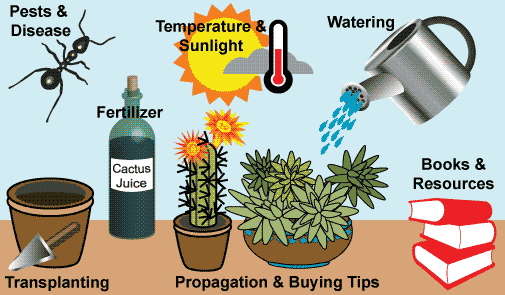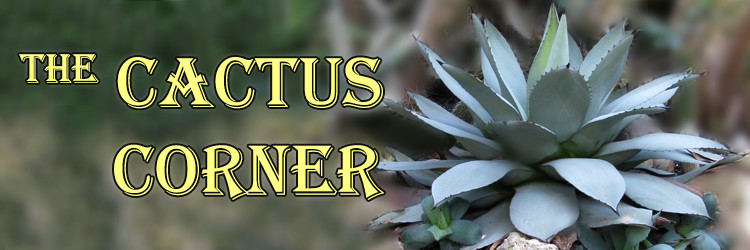General Plant Care
Intro
Cacti and Succulents generally require less water than most plants. This is because they store water in their fleshy bodies or leaves for the arid dry times of the year.
However, that does not mean that they should not be watered or cared for. Every plant is different and it is important to research either through books or the internet what type of care your desert plant requires.
Click on the images in the image map to discover more about the type of care your Cacti or Succulent needs:

How & When to Water
As mentioned, most desert plants require little water, but not all Cacti and Succulents live in the desert, some like Epiphyllum and "Christmas Cacti" live in rainforests.
When buying or starting a collection it is important to consider this: How often will I have to water my plant based on the natural habitat it came from?
If the native plant lived in the deserts of Mexico or Texas it may need some water in summer, but very little during the cold months of winter. If it lived in the tropics then it may need moisture and humidity all year round.
When watering it is always best to water at the base of the desert plant. Cacti and Succulents don't like water to remain on their leaves when they are in direct sunlight. The water droplets act like magnifying glasses and burn the plant. Neither do they like to be over-watered because this can cause rot.
It's best to water the plant when the soil is bone dry. Then water thoroughly and only water again when the soil is dry once more. This watering may be every day in summer and once a week in winter.
Over time, if you have success with a plant, you will learn its watering likes and dislikes. I find even with the Echeveria, different species with in the genus may have slightly different needs. (map)
When & How to Transplant
Transplanting usually should occur when one or all of the following is happening:
- The plant is getting too big for its container and is suffering
- When trying to remove offshoots for putting in another container
- If the plant is dying and you need to determine the cause
For Cacti and Succulents that have extremely sharp needle-like points it's best to remove the plant with thick leather gloves and newspaper. Wrap the newspaper around the plant, turn upside down and gently pull it out of the old container. For plants with no spines, pulling the plant out just wearing gloves is fine.
Once the plant is removed, check the plant for disease and slightly loosen the roots. Wash the roots with water if you see any "mealy bugs". (see Pests)
In the case of an Echeveria or Aeonium the plant over time becomes too tall, you can cut the stem and place in the ground and it will keep on growing. This is a normal and natural way for these types of plants. Also make sure to check for any young offshoots which can be removed. (see Propagation)
Once the plant is removed, place it in a clean decorative ceramic or clay container with a drainage hole. The soil should be a mixture of fresh garden soil (found at most garden shops) and sand.
First put a little soil around the bottom of the container and then place the plant inside, putting more soil on the sides and up around the base of the stem until it reaches the top of the container and then water so the soil will settle and flow around the roots.
Depending on how fast the plant grows or how large the container is you probably will not have to transplant again for a year or so.(map)
Types of Fertilizer
Cacti and Succulents require a different fertilizer than other plants. Make sure to check with the local garden shop or florist what kind of liquid fertilizer they suggest and follow the instructions on the package. Sometimes plants need more fertilizer during the winter months to help them cope with the different temperatures. (map)
Pests & Disease
Some bug pests are more common than others depending on where the plant is residing or its species.
The most common types of pests and disease are:
- Ants
- Aphids
- Mealy bugs
- Red Spider Mites
- Slugs and Snails
- Rot
First it is important to determine which plant is suffering and if it has spread to other plants.
In the case of ants, the infected plants should be removed for a time from the others in the collection and have the roots washed and be replanted in a new clean container (See Transplanting). Then see if the problem returns before returning the plant to the group.
In the case of Aphids, Mealy bugs, and Red Spider Mites a similar procedure could be followed as just mentioned. However, these pest are often found on the leaves or on the stem of the plant. You could spray the plant with a pesticide, but this often kills the plant first. If the plant is badly infected, it should be removed from the group and destroyed.
With Slugs and Snails, transplanting is the best option and then place slug bait somewhere near the plants to attract them to that instead.
Rot is considered a disease. Make sure first you’re not over-watering. If possible try to recover what parts of the plant are not rotting such as offshoots and leaves and re-grow new plants and throw the rotted part away.
Most of these pest problems can be avoided if you transplant the plant out of its old container as soon as you buy it. Place it in a new clean container with fresh soil and keep separated from the other plants for a week to monitor whether any disease or pests appear. (see Buying Tips) (map)
Temperature, Heating the Greenhouse in winter and Sunlight
Temperature is dependant upon the type of plant and where it's native to. Most desert plants should not go below 25°F as they can freeze to death.
It's best to keep your plant indoors during winter near the window so it can get sunlight, or in your sealed, heated greenhouse to keep the temperature above the freezing level.
Container plants in the greenhouse should be placed on a mesh table and near the heater so that air can flow all around the plant keeping it warm.
Also remember to keep the level of humidity even, depending on the type of plants you are growing. Not all Cacti and Succulents like dry heat.
Sunlight is important to all Cacti and Succulents, however depending on the variety, they may prefer partial or filtered sunlight, not direct which could sunburn. As before, even within one genus different species may have slightly different needs. (map)
Recommended Books & Further Resources
For more information on plant care, please refer to the following books and links:
- "The World of Cactus & Succulents" published by Ortho Books
- "Cactus and Succulents: a care manual" by Tony and Suzanne Mace
- "The Complete Book of Cacti & Succulents" by Terry Hewitt
- Cactus Corner Resources
- Cactus Corner Propagation & Buying Tips






